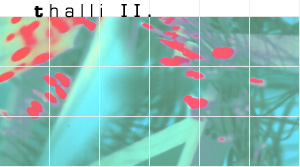Thalli II.
computer installation; wood, paper, electronic circuits, 2000
It is a well-known phenomenon that certain biological constructions are incapable of living in a sterile environment. In these cases, researchers add accidental elements, they mix some 'noise' into the system. What this noise can be? How could it happen, that these accidental flaws can galvanize life into these otherwise frozen models? My work, which is the first part of a longer series, analyses this phenomenon. For the first time I chose a classical model.
The Neumann cellular automats are population models. They are not really biological models, rather some sort of 'modell modells', population games. If their rules are cleverly defined they can stay alive and in motion for many generations, but after a while they always freeze and their evolution stop. The cellular automat, built in my installation, can be waken up from its 'sleeping beauty dream' by the presence of the visitor. It is the visitor, who makes that certain noise, essential for continuous functioning.
related:
Thalli I.
Thalli III.
Thalli IV.
exhibitions:
C3 ou la jeune création - Paris 2002,
Maison Européenne de la Photographie, Paris
Média modell - Budapest, 2000,
Mûcsarnok
Need for Motion - Budapest, 2000,
Trafó
